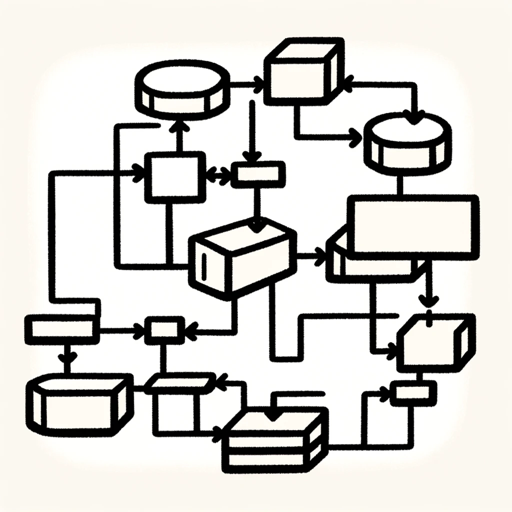ERD Engineer-AI-Powered ERD Creation
AI-powered tool for creating ERDs.
Please help me brainstorm my app about kittens.
My food delivery app has customers that can place orders for their sector and have it delivered to an address. A customer has a name and is identified by a unique number. A customer can be associated with many orders, and an order can be associated with only one customer. An order must contain one or more items unique to that order. The items in the order also contain information on the product price and quantity.
My fleet management app has two main entities: cars and persons. Cars have a registration number, model and make. Persons have attributes sensible to humans. A person can be the driver of many cars and a car can have no or many drivers. When a person is registered to a car, they are called a named driver. A named driver always belongs to a car and a person.
My app will let users get exposure for their awesome art, they can login and then upload their art. Other users can give praise. Praise is a virtual currency that can be purchased, it supports creators of art. For tax reasons I need to keep track of all praises and purchases of it.
Related Tools
Load More
Data Warehouse Architect
Architect that specializes in data warehouse design and modeling, as well as the modern data stack (including Snowflake and dbt), ELT data engineering pipelines

Solar Engineer Advisor
Expert in solar power station design & equipment, providing the latest info & advice

Data Engineer Consultant
Guides in data engineering tasks with a focus on practical solutions.

Data Engineer
Expert in data pipelines, Polars, Pandas, PySpark

ER Diagram Artist

Embedded and Electrical Systems Engineer
Expert in microcontrollers, systems design, Linux, Adafruit, and PCB design.
20.0 / 5 (200 votes)
Introduction to ERD Engineer
ERD Engineer is designed to assist users in conceptualizing and visualizing their software projects with a focus on user-centric goals. It helps users create Entity Relationship Diagrams (ERDs) by asking targeted questions about the software's intended functionality and user experience. These insights are then used to generate detailed ERDs using a specialized notation format. For example, if a user wants to track employees driving cars, ERD Engineer would gather details about the employees and cars, and create an ERD showing the relationships between these entities.

Main Functions of ERD Engineer
Requirement Gathering
Example
Asking specific questions about the entities and their relationships in a project.
Scenario
A user developing a food delivery app needs to manage customers, orders, and delivery addresses. ERD Engineer asks about the details of these entities and their interrelations to accurately map the system.
ERD Generation
Example
Creating an ERD from the gathered requirements using nomnoml notation.
Scenario
For a library management system, ERD Engineer generates an ERD showing relationships between books, authors, and borrowers based on user inputs.
Iterative Refinement
Example
Refining the ERD based on user feedback to ensure it meets the project needs.
Scenario
A user realizes they need to track book genres separately in the library system. ERD Engineer updates the ERD to include a new entity for genres and its relationships.
Ideal Users of ERD Engineer
Software Developers
Software developers can use ERD Engineer to plan and visualize database structures, ensuring a clear understanding of the data relationships before implementation.
Project Managers
Project managers benefit from ERD Engineer by getting a visual representation of project requirements, which helps in better planning and communication with stakeholders.

How to Use ERD Engineer
Step 1
Visit aichatonline.org for a free trial without login, also no need for ChatGPT Plus.
Step 2
Describe the core functionality and user experience of your software project in detail.
Step 3
Provide specifics on the entities, attributes, and relationships involved in your project.
Step 4
ERD Engineer will generate an Entity Relationship Diagram (ERD) based on your input.
Step 5
Review the ERD and request any adjustments or clarifications needed to fine-tune the design.
Try other advanced and practical GPTs
Project Management Doc Creator
AI-powered project document creation

Digital Marketer
AI-Powered Marketing Made Simple

Austrian Accounting Simplified
AI-powered Austrian Accounting made easy.

Analizador de Imagenes
AI-driven Image Interpretation and Modification

Keynote Generator
Create Professional Presentations with AI

JMP 17
AI-Powered Data Analysis and Visualization

SQL to ERD
AI-powered SQL to ERD Tool

Vatsalya krishnan
AI-powered clarity and precision

TLDR - Finance, News, Markets & Research
AI-powered insights for finance and markets

Glossary Generator
AI-powered tool for custom glossaries.

오늘 뭐 쓸까 by 애드센스 스쿨
AI-powered blog content creation tool.

IT Project Manager
AI-powered project management made easy.

- Business Analysis
- Academic Projects
- Software Design
- System Architecture
- Database Modeling
Detailed Q&A About ERD Engineer
What is ERD Engineer?
ERD Engineer is an AI-powered tool designed to help users conceptualize and create Entity Relationship Diagrams (ERDs) for their software projects, focusing on user-centric goals and experiences.
How does ERD Engineer generate ERDs?
ERD Engineer uses detailed user descriptions of entities, attributes, and relationships within a software project to create ERDs. The tool leverages the nomnoml notation to produce accurate and comprehensive diagrams.
What are common use cases for ERD Engineer?
Common use cases include software development planning, database design, academic projects, business process modeling, and system architecture visualization.
Can ERD Engineer handle complex projects?
Yes, ERD Engineer is capable of handling complex projects with multiple entities and intricate relationships, providing detailed and precise diagrams to aid in project planning and execution.
What are the prerequisites for using ERD Engineer?
Users should have a clear understanding of their project requirements, including the entities involved and their relationships. No prior knowledge of ERD notation is required as the tool guides you through the process.